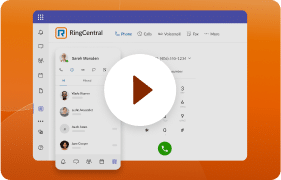If you run a business, it’s important that your customers, clients, and suppliers can contact you. Even when you’re not able to answer the phone, your callers should still be able to get their message across. If they can’t, you might lose business and valuable contacts to competitors.
A good voicemail system is vital for this. But you might be wondering, “what exactly makes a good voicemail system, how does voicemail work, and how do I get to my voicemail to find out what messages people have left for me?
Let’s find out.
What is voicemail?
Voicemail allows you to record a message for your recipient and leave it in a “mailbox.” The recipient can then open their voicemail and listen to your message at a time that suits them.
Analog voicemail relied upon physical recordings, which took up a lot of space (both digital and physical). Modern voicemail systems are more sophisticated.
Modern voicemail stores voice messages as data packets that can hold much more data than traditional voicemail systems and can be accessed through the internet as well as via your phone.
Providers like RingCentral go the extra mile with voicemail by providing features like visual voicemail, which displays a transcript of your messages to read rather than listen to, and also allows you to pick which messages you want to listen to first.
Voicemail features
Features of good modern voicemail systems include:
- The ability to set a voicemail PIN: This is essential for protecting the privacy of both yourself and the people calling you.
- Custom voicemail greetings: This enables users to record different greetings for different purposes and switch between them whenever needed. For example, you might want to use one voicemail greeting when you’re briefly out of the office and another when you’re on vacation.
- Distribution lists: These let callers leave messages for larger groups of people. For example, you can use a distribution list to message a whole department or team.
- Tagging: For example, RingCentral allows you to tag messages as “Urgent.”
- A range of playback options: These include rewind, fast forward, and replay.
- Message information: This includes caller ID, date, and time.
How to listen to voicemail
So, if you’re wondering, “How do I listen to my voicemail?”, the answer is that it depends on your phone provider. Usually, you’ll be able to listen to your voicemail by calling the voicemail service from your phone:
Using Android
If you’re an Android user, there’s no need to worry about how to dial voicemail because the easiest way to access your voicemail is to tap on the notification that appears when someone leaves you a message. That being said, it’s not the only way to do it.
If you want to get to your voicemail and there’s no notification to click on, dial your voicemail from the dial pad. If you’re thinking, “what do I need to dial for voicemail?”, there’s an easy way to find out:
- Open your Phone app.
- Click the three dots next to “Search contacts.”
- Open “Settings.”
- Open “Voicemail.”
- Open “Advanced Settings.”
- Open “Setup.”
Your voicemail number will be displayed on the Setup screen.
If you have a Samsung phone, you can open your voicemail by holding down 1 on the dial pad for a few seconds.
If you’re away from your own phone, you can access your voicemail from another phone by dialing your own number. When asked to leave a voicemail, press the * key and enter your voicemail PIN to hear your messages.
Using iPhone
If you’re an iPhone user, you’re probably thinking, “OK, so we know how Android users can listen to their voicemail, but how do I get my voicemail?”.
Well, it’s also pretty simple. Apple iPhones have a shortcut to voicemail within the phone app. When you enter the phone app and click “Voicemail,” you’ll be presented with a list of messages, including the ID of each caller. New messages will show a blue circle next to them.
Another way to check your iPhone voicemails is to enter the “Missed calls” screen. If a caller has left you a message, there will be a red notification next to the call details. Clicking it will take you to your voicemail screen.
How to check voicemail in RingCentral
If you’ve made the excellent decision to sign up with RingCentral and you’re wondering, “How do I dial my voicemail?”, we’re glad to tell you that there are two easy ways to get to your voicemail. You can either access your voicemail over the phone or via your online account:
Using your phone
So, how do I access my voicemail on my phone if I’m a RingCentral customer? To access your RingCentral voicemails through your RingCentral IP deskphone, simply dial *86.
To reach your RingCentral voicemail from other phones, either call your RingCentral number and enter your extension number, or call your RingCentral Direct number.
Having dialed into your RingCentral account, press the * key, followed by your voicemail PIN, followed by the # key.
You’ll then be presented with a range of options. Pick an option, or press 1 to simply listen through your messages.
Using your online account

You can also access your voicemail through your online RingCentral account. Here’s how:
Firstly, log into your RingCentral account.
Then, click “Messages,” followed by “Inbox.” If you’re signed in as an administrator, you can access your messages via the Admin Portal (found in the top right-hand corner of your dashboard) by switching to “My Extension” to view your own voicemails.
Having opened your voicemail inbox, you’ll see a visual voicemail list of messages, including details like the caller ID and the date and time the messages were left. Some callers may also have tagged their messages with things like “Urgent” or with the topic of the message.
You can listen to messages by clicking the “Play” button next to the message details. You can also view transcripts of each voicemail or download the recordings to listen to offline.
Other methods of checking voicemail on Android devices
We’ve gone through a couple of methods of checking Android voicemail above, but here are some more, just in case you need them:
Use a third-party app
Android doesn’t have a dedicated voicemail app, but it’s easy enough to download third-party voicemail apps on Android devices. Popular examples include YouMail, Google Voice, and Voxist.
You may find that your cell network has its own voicemail app. For example, AT&T has a dedicated visual voicemail app that comes as standard on all their cell networks, and Verizon customers can get voicemail through the Verizon Call Assistant website.
Use an enabled visual voicemail
You could also enable visual voicemail on your Android phone to get a full visual rundown of your messages. Not all regions offer this service, but for those that do, it’s a simple process:
- Go into your phone app
- Tap the three dots in the top right-hand corner
- Go into voicemail settings
- Turn on Visual Voicemail
Some Android devices (for example, Samsung Galaxy S series devices) have a dedicated visual voicemail app. You’ll have to give the app permission to access your contacts, call logs, etc., but once you do this, it’s very easy to use.
Other methods of checking voicemail on iPhone
Now let’s take a look at a couple of other ways to check your voicemail on an iPhone:
Use Siri
Siri can easily access your voicemail. So, if you’re not sure how to do it (or if you need a hands-free voicemail solution), simply say “Hey Siri” (or open Siri’s app by pressing and holding the Home button), and ask Siri if you have any voicemails.
Siri will then display or read out a list of voicemails and ask if you want to play any. You can then instruct Siri to play any voicemail you want to hear.
Siri will obey all the usual voicemail commands, including “Play the next message,” “Replay the last message,” etc.
Use voicemail transcription
Voicemail transcription is a simple way to turn your voicemails into text. iPhones aren’t perfect at doing this. In order to transcribe successfully, your phone needs to run iOS10 or a later iOS, and the message needs to be high quality, in English, and preferably pretty short.
Voicemail shortcut keys
Most good voicemail providers will give you plenty of shortcut keys to help you out both during and after playback. These keys vary between providers and carriers, but most include something like the following list:
| During playback | After playback |
| Rewind | Save message |
| Pause | Delete message |
| Fast forward | Reply with a text message |
| Decrease playback speed | Return call |
| Increase playback speed | Replay message |
| Announce the sender, time, and date | Send a copy |
| Increase playback volume | Play message envelope information |
| Decrease playback volume | Other options |
| Skip message | |
| Delete message |
RingCentral voicemail keys
Managing your RingCentral voicemail is easy. You can use these keys to use many RingCentral voicemail functions:
- 1 – Replay voicemail
- 2 – Save voicemail
- 3 – Delete voicemail
- 4 – Return call
- 5 – Forward the voicemail to a different extension on your account
- 6 – Skip voicemail
- * – Exit voicemail
Voicemail keys for popular phone carriers
Different voicemail carriers use different voicemail keys. Here’s a list of voicemail keys for popular US phone carriers:
| Carrier | Save message key | Delete message key | Replay message key | Return call/Reply key |
| AT&T | 3 | 2 | 1 | 4 |
| Verizon | 9 | 7 | 4 | 88 |
| T-Mobile | 9 | 7 | 1 | 8 |
| Boost Mobile | 9 | 7 | 1 | 8 |
| USCellular | 2 | 3 | 1 | 5, then 2 |
How to change your voicemail settings
Here’s how to change your voicemail settings in RingCentral:
- Go into “Settings.”
- Click “Phone Settings.”
- Choose “Call Rules” and “Voicemail.” Here, you can make various changes to your voicemail settings, including forwarding all calls to voicemail and setting your phone to “Do not disturb.”
- In order to customize your voicemail greeting, go into “My work day” and click “Incoming Calls.”
- Scroll to “If no one answers” and open the dropdown menu.
- Select “Send To Voicemail.”
- Click “Voicemail Greeting” to customize your greeting.
What to do if your voicemail notifications don’t work
If your voicemail notifications aren’t working, there are a couple of things that might solve the problem:
- Check your network connection
- Check your voicemail settings to make sure that notifications are turned on
- Check your permissions to make sure that you’ve given permission for voicemail to send you notifications
- Make sure that your voicemail is activated
If none of these solve the issue, get in touch with your voicemail provider or phone carrier for support.
Voicemail capacity
The higher your voicemail capacity, the more voicemails you can store. This is especially useful if you run a small business and are likely to be away for some time.
Rather than getting frustrated, your customers will be directed through your business voicemail greetings to leave a message, which you can respond to when you return.
A large voicemail capacity means that no customer needs to feel like they’re unable to get their message across.
RingCentral accounts can store up to 200 combined fax messages and voicemails for up to 30 days. This gives you plenty of scope to be away from your phone without missing any important calls.
How do you get to your voicemail? However you like
Voicemail is an incredibly useful feature that makes sure you never miss a message from customers, family, friends, or anyone else who might be calling.
RingCentral’s voicemail features are among the best around. To find out more about what RingCentral can do for you, why not sign up for our free trial?
FAQs about voicemail
What number do I need to dial for my voicemail?
The number you dial for voicemail will vary depending on your phone provider and the system you’re using.
Samsung Galaxy users simply need to hold down 1 on their dial pad to access their voicemail. Other devices require different numbers, which can usually be found in their device settings or on their telephone app.
How much does it cost to use voicemail?
The cost of using voicemail varies depending on your call provider and the services you use. With RingCentral, voicemail is included as standard within your subscription.
What is visual voicemail?
Visual voicemail is a text-based voicemail format. It can sometimes be image-based, too. Visual voicemail includes voicemail menus that clearly show you who has called, when they called, how long their message is and so on.
This sort of visual voicemail menu also lets you pick which messages you want to listen to, rather than having to listen to each voicemail in order.
Another useful aspect of visual voicemail is transcription. Providers like RingCentral can transcribe voice messages, allowing you to read through each voicemail at your convenience.
Originally published Aug 18, 2024, updated Nov 25, 2024













